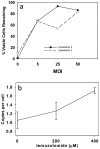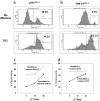Engineered drug resistant γδ T cells kill glioblastoma cell lines during a chemotherapy challenge: a strategy for combining chemo- and immunotherapy
- PMID: 23326319
- PMCID: PMC3543433
- DOI: 10.1371/journal.pone.0051805
Engineered drug resistant γδ T cells kill glioblastoma cell lines during a chemotherapy challenge: a strategy for combining chemo- and immunotherapy
Abstract
Classical approaches to immunotherapy that show promise in some malignancies have generally been disappointing when applied to high-grade brain tumors such as glioblastoma multiforme (GBM). We recently showed that ex vivo expanded/activated γδ T cells recognize NKG2D ligands expressed on malignant glioma and are cytotoxic to glioma cell lines and primary GBM explants. In addition, γδ T cells extend survival and slow tumor progression when administered to immunodeficient mice with intracranial human glioma xenografts. We now show that temozolomide (TMZ), a principal chemotherapeutic agent used to treat GBM, increases the expression of stress-associated NKG2D ligands on TMZ-resistant glioma cells, potentially rendering them vulnerable to γδ T cell recognition and lysis. TMZ is also highly toxic to γδ T cells, however, and to overcome this cytotoxic effect γδ T cells were genetically modified using a lentiviral vector encoding the DNA repair enzyme O(6)-alkylguanine DNA alkyltransferase (AGT) from the O(6)-methylguanine methyltransferase (MGMT) cDNA, which confers resistance to TMZ. Genetic modification of γδ T cells did not alter their phenotype or their cytotoxicity against GBM target cells. Importantly, gene modified γδ T cells showed greater cytotoxicity to two TMZ resistant GBM cell lines, U373(TMZ-R) and SNB-19(TMZ-R) cells, in the presence of TMZ than unmodified cells, suggesting that TMZ exposed more receptors for γδ T cell-targeted lysis. Therefore, TMZ resistant γδ T cells can be generated without impairing their anti-tumor functions in the presence of high concentrations of TMZ. These results provide a mechanistic basis for combining chemotherapy and γδ T cell-based drug resistant cellular immunotherapy to treat GBM.
Conflict of interest statement
Figures





Similar articles
-
CMV-independent lysis of glioblastoma by ex vivo expanded/activated Vδ1+ γδ T cells.PLoS One. 2013 Aug 7;8(8):e68729. doi: 10.1371/journal.pone.0068729. eCollection 2013. PLoS One. 2013. PMID: 23950874 Free PMC article.
-
Adoptive cell therapy for high grade gliomas using simultaneous temozolomide and intracranial mgmt-modified γδ t cells following standard post-resection chemotherapy and radiotherapy: current strategy and future directions.Front Immunol. 2024 Feb 7;15:1299044. doi: 10.3389/fimmu.2024.1299044. eCollection 2024. Front Immunol. 2024. PMID: 38384458 Free PMC article.
-
Preclinical evaluation of ex vivo expanded/activated γδ T cells for immunotherapy of glioblastoma multiforme.J Neurooncol. 2011 Jan;101(2):179-88. doi: 10.1007/s11060-010-0245-2. Epub 2010 Jun 10. J Neurooncol. 2011. PMID: 20532954
-
Progression of O⁶-methylguanine-DNA methyltransferase and temozolomide resistance in cancer research.Mol Biol Rep. 2014 Oct;41(10):6659-65. doi: 10.1007/s11033-014-3549-z. Epub 2014 Jul 3. Mol Biol Rep. 2014. PMID: 24990698 Review.
-
Anti-glioma therapy with temozolomide and status of the DNA-repair gene MGMT.Anticancer Res. 2009 Nov;29(11):4845-54. Anticancer Res. 2009. PMID: 20032445 Review.
Cited by
-
Tumor Infiltrating Lymphocyte (TIL) Therapy for Solid Tumor Treatment: Progressions and Challenges.Cancers (Basel). 2022 Aug 27;14(17):4160. doi: 10.3390/cancers14174160. Cancers (Basel). 2022. PMID: 36077696 Free PMC article. Review.
-
Allogeneic gamma delta T cells as adoptive cellular therapy for hematologic malignancies.Explor Immunol. 2022;2(3):334-350. doi: 10.37349/ei.2022.00054. Epub 2022 Jun 7. Explor Immunol. 2022. PMID: 35783107 Free PMC article.
-
Gamma Delta T-Cell Based Cancer Immunotherapy: Past-Present-Future.Front Immunol. 2022 Jun 16;13:915837. doi: 10.3389/fimmu.2022.915837. eCollection 2022. Front Immunol. 2022. PMID: 35784326 Free PMC article. Review.
-
Single vs. combination immunotherapeutic strategies for glioma.Expert Opin Biol Ther. 2017 May;17(5):543-554. doi: 10.1080/14712598.2017.1305353. Epub 2017 Mar 20. Expert Opin Biol Ther. 2017. PMID: 28286975 Free PMC article. Review.
-
Targeting NKG2D ligands in glioblastoma with a bispecific T-cell engager is augmented with conventional therapy and enhances oncolytic virotherapy of glioma stem-like cells.J Immunother Cancer. 2024 May 9;12(5):e008460. doi: 10.1136/jitc-2023-008460. J Immunother Cancer. 2024. PMID: 38724464 Free PMC article.
References
-
- Castro MG, Cowen R, Williamson IK, David A, Jimenez-Dalmaroni MJ, et al. (2003) Current and future strategies for the treatment of malignant brain tumors. Pharmacol Ther 98: 71–108. - PubMed
-
- Merchant RE, Ellison MD, Young HF (1990) Immunotherapy for malignant glioma using human recombinant interleukin-2 and activated autologous lymphocytes. A review of pre-clinical and clinical investigations. J Neurooncol 8: 173–188. - PubMed
-
- Mahaley MS Jr, Bertsch L, Cush S, Gillespie GY (1988) Systemic gamma-interferon therapy for recurrent gliomas. J Neurosurg 69: 826–829. - PubMed
Publication types
MeSH terms
Substances
Grants and funding
LinkOut - more resources
Full Text Sources
Other Literature Sources
Research Materials
Miscellaneous

